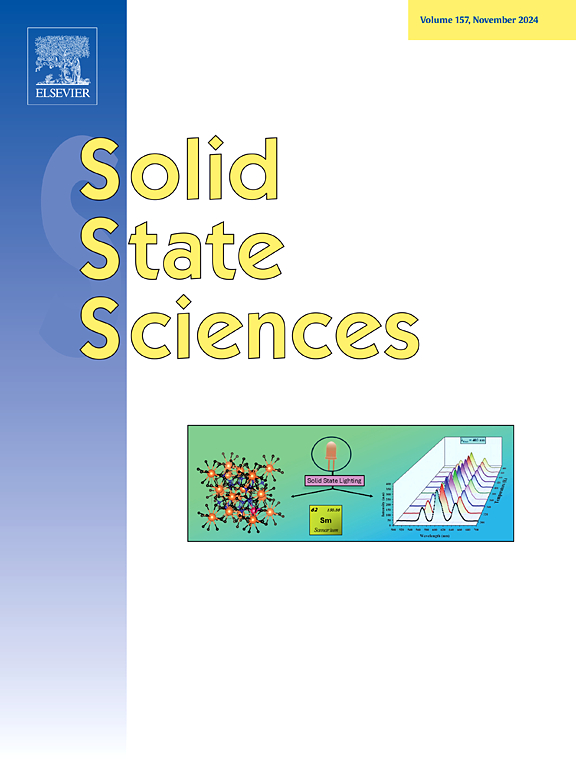高性能柔性超级电容器用石墨化氮化碳/Cd2SnO4纳米结构的合成与表征
IF 3.4
3区 化学
Q2 CHEMISTRY, INORGANIC & NUCLEAR
引用次数: 0
摘要
基于异质结的电极材料的发展为提高电化学性能提供了一种有前途的方法,为未来储能应用的发展提供了潜力。在这项研究中,石墨化氮化碳(g-C3N4)基质作为一个支持网络,调节锡酸镉(Cd2SnO4)纳米颗粒(NPs)的聚集,从而在电化学循环中提供了良好的稳定性。优化后的g-C3N4/Cd2SnO4复合材料表现出优异的电化学性能,具有较高的比电容和更好的循环稳定性。复合材料的x射线衍射(XRD)图显示了不同组分的不同晶相,证实了复合材料的正交结构。在酸性水溶液和凝胶电解质(PVA/H2SO4)介质中评价了所合成电极材料的电化学电荷存储性能。结果表明:在所制备的电极材料中,g-C3N4/Cd2SnO4样品在0.5 Ag-1时的电化学电容最高,为601.20 Fg-1;即使在5000次充放电循环后,电极仍保持其循环稳定性,电容保持率为94.69%。g-C₃N₄/Cd2SnO4电极在凝胶聚合物电解质中通过组装对称电容器进行实际应用,进一步评估了其性能。凝胶电解质的使用使得该装置在1.0 V的电压范围内,在0.5 ag⁻1的工作电流密度下,可以实现48.81 Wh kg - 1的能量密度和250 W kg - 1的功率密度。值得注意的是,g-C₃N₄/Cd2SnO4电极在凝胶电解质中表现出很强的循环稳定性,可保持高达5000次循环的性能。此外,凝胶电解质中的对称器件在各种弯曲角度上都表现出优异的电化学稳定性,突出了其作为超级电容器柔性电极的潜力。本文章由计算机程序翻译,如有差异,请以英文原文为准。

Synthesis and characterization of graphitic carbon Nitride/Cd2SnO4 nanostructures for high-performance flexible supercapacitors
The development of electrode materials based on heterojunctions shows a promising approach for enhancing electrochemical performance, offering the potential for future advancements in energy storage applications. This investigation, a graphitic carbon nitride (g-C3N4) matrix functioned as a supportive network, regulating the aggregation of cadmium stannate (Cd2SnO4) nanoparticles (NPs) thereby giving promising stability during electrochemical cycling. The optimized g-C3N4/Cd2SnO4 composite demonstrated excellent electrochemical performance, characterized by a high specific capacitance and improved cycling stability. X-ray diffraction (XRD) patterns of the composite revealed distinct crystalline phases of individual components, confirming the orthorhombic structure of the composite. The electrochemical charge storage performance of the synthesized electrode material has been evaluated in an aqueous acidic and gel-electrolyte (PVA/H2SO4) medium. The results indicate that among the prepared electrode materials, the g-C3N4/Cd2SnO4 sample exhibits the highest electrochemical capacitance of 601.20 Fg-1 at 0.5 Ag-1. Even after 5000 charge-discharge cycles, the electrode maintained its cycling stability with 94.69 % capacitance retention. The performance of the g-C₃N₄/Cd2SnO4 electrode was further evaluated in a gel polymer electrolyte by assembling a symmetric capacitor for real-world application using a two-electrode system. The use of a gel electrolyte allowed the device to achieve an energy density of 48.81 Wh kg⁻1 and a power density of 250 W kg⁻1 within a voltage window of 1.0 V at an operating current density of 0.5 A g⁻1. Notably, the g-C₃N₄/Cd2SnO4 electrode demonstrated strong cycling stability in the gel electrolyte, maintaining performance for up to 5000 cycles. Furthermore, the symmetric device in the gel electrolyte exhibited excellent electrochemical stability across various bending angles, highlighting its potential for use as a flexible electrode in supercapacitors.
求助全文
通过发布文献求助,成功后即可免费获取论文全文。
去求助
来源期刊

Solid State Sciences
化学-无机化学与核化学
CiteScore
6.60
自引率
2.90%
发文量
214
审稿时长
27 days
期刊介绍:
Solid State Sciences is the journal for researchers from the broad solid state chemistry and physics community. It publishes key articles on all aspects of solid state synthesis, structure-property relationships, theory and functionalities, in relation with experiments.
Key topics for stand-alone papers and special issues:
-Novel ways of synthesis, inorganic functional materials, including porous and glassy materials, hybrid organic-inorganic compounds and nanomaterials
-Physical properties, emphasizing but not limited to the electrical, magnetical and optical features
-Materials related to information technology and energy and environmental sciences.
The journal publishes feature articles from experts in the field upon invitation.
Solid State Sciences - your gateway to energy-related materials.
 求助内容:
求助内容: 应助结果提醒方式:
应助结果提醒方式:


